4권 4호
초록
The intricate relationship between species and their ecosystems has been a focal point of ecological research for decades. With the advent of big data and artificial intelligence, we are now able to explore this relationship with unprecedented depth and precision. This review delves into the transformative role of these technologies in ecological research, emphasizing their potential to enhance our understanding of species-ecosystem linkages.
Abstract
The intricate relationship between species and their ecosystems has been a focal point of ecological research for decades. With the advent of big data and artificial intelligence, we are now able to explore this relationship with unprecedented depth and precision. This review delves into the transformative role of these technologies in ecological research, emphasizing their potential to enhance our understanding of species-ecosystem linkages.
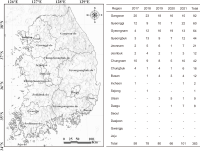
초록
This study surveyed the changes in the proportion of Ecological and Natural Map (ENM) grades in Korea, the distribution ratio of ENM 1st-grade areas by region, and the current status of regional public appeals for the five-year period from 2017 to 2021. The nationwide changes in ENM grades revealed an increase in 1st-grade, 3rd-grade, and separately managed areas but a decrease in the ratio of 2nd-grade areas. Nationwide, Gangwon had the highest distribution ratio of 1st-grade areas, at 46.77%, while Gwangju had the lowest, at 0.05%. In the five-year study period, 383 appeals concerning ENM grades were received and processed. Gangwon had the greatest number of appeals, with 96, while Sejong had the fewest, with 1. A significant correlation was observed between the distribution ratio of 1st-grade areas and public appeals.
Abstract
This study surveyed the changes in the proportion of Ecological and Natural Map (ENM) grades in Korea, the distribution ratio of ENM 1st-grade areas by region, and the current status of regional public appeals for the five-year period from 2017 to 2021. The nationwide changes in ENM grades revealed an increase in 1st-grade, 3rd-grade, and separately managed areas but a decrease in the ratio of 2nd-grade areas. Nationwide, Gangwon had the highest distribution ratio of 1st-grade areas, at 46.77%, while Gwangju had the lowest, at 0.05%. In the five-year study period, 383 appeals concerning ENM grades were received and processed. Gangwon had the greatest number of appeals, with 96, while Sejong had the fewest, with 1. A significant correlation was observed between the distribution ratio of 1st-grade areas and public appeals.





초록
This study aimed to conduct a comprehensive survey of social wasp diversity and its impacts on remote Ulleungdo Island, South Korea. A total of 12 wasp traps were placed across the island, and specimens were collected monthly from May to October. Additional collection was conducted by thoroughly inspecting the areas surrounding the traps. The traps yielded a total of 5,068 individuals, representing two genera and two species. A total of 3,961 Vespa simillima simillima Smith individuals (78.2%) were collected, and 1,107 individuals (21.8%) were identified as Vespula flaviceps flaviceps Smith. Additionally, five individuals of Polistes snelleni de Saussure were collected through sweeping, bringing the total to 5,132 individuals of three genera and three species. It is worth noting that our findings indicate potential misidentifications in the species list of Vespidae found in the literature. Emergency services call centers reported the removal of 60 social wasp nests on Ulleungdo Island between 2018 and 2022, with the highest number of reports occurring from July to September, accounting for 87% of all cases. Dodong-ri and Jeodong-ri, with the highest populations, reported the most incidents, although fortunately, there have been no recent injuries. Past incidents involving the destruction of dried squid products by Vespula species have resulted in significant economic losses, underscoring the need for preventative measures. Furthermore, ongoing surveillance of hornet invasions is essential to safeguard the Jangwon bees being reared on Ulleungdo Island.
Abstract
This study aimed to conduct a comprehensive survey of social wasp diversity and its impacts on remote Ulleungdo Island, South Korea. A total of 12 wasp traps were placed across the island, and specimens were collected monthly from May to October. Additional collection was conducted by thoroughly inspecting the areas surrounding the traps. The traps yielded a total of 5,068 individuals, representing two genera and two species. A total of 3,961 Vespa simillima simillima Smith individuals (78.2%) were collected, and 1,107 individuals (21.8%) were identified as Vespula flaviceps flaviceps Smith. Additionally, five individuals of Polistes snelleni de Saussure were collected through sweeping, bringing the total to 5,132 individuals of three genera and three species. It is worth noting that our findings indicate potential misidentifications in the species list of Vespidae found in the literature. Emergency services call centers reported the removal of 60 social wasp nests on Ulleungdo Island between 2018 and 2022, with the highest number of reports occurring from July to September, accounting for 87% of all cases. Dodong-ri and Jeodong-ri, with the highest populations, reported the most incidents, although fortunately, there have been no recent injuries. Past incidents involving the destruction of dried squid products by Vespula species have resulted in significant economic losses, underscoring the need for preventative measures. Furthermore, ongoing surveillance of hornet invasions is essential to safeguard the Jangwon bees being reared on Ulleungdo Island.

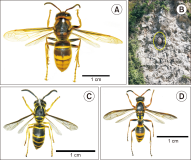


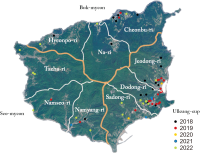

초록
The Asiatic black bear, Ursus thibetanus, is among the most threatened or endangered species in Asia. For its conservation and management, sex identification of U. thibetanus using non-invasive samples (e.g., hair and/or feces) is potentially valuable. In this study, a non-invasive molecular method for sex identification of U. thibetanus samples collected from various countries was first utilized, and it was based on polymerase chain reaction (PCR) amplification of the amelogenin gene via PCRs. Thirty-three bear DNA samples, extracted not only from blood (n=9) but also from hair (n=18) and feces (n=6), were used. We performed sex-specific PCR amplifications of the amelogenin gene using a primer set, SE47 and SE48. The primer set could successfully amplify a single X-specific band for females and both X- and Y-specific bands for males from all blood (100%) and hair (100%) samples. In addition, the primer set could distinguish the sex of bears in four out of a total of six fecal samples (approximately 67%). This study’s findings suggest that this molecular method can be applied to sex identification of Asiatic black bears from various Asian regions using non-invasive samples, such as hair and feces.
Abstract
The Asiatic black bear, Ursus thibetanus, is among the most threatened or endangered species in Asia. For its conservation and management, sex identification of U. thibetanus using non-invasive samples (e.g., hair and/or feces) is potentially valuable. In this study, a non-invasive molecular method for sex identification of U. thibetanus samples collected from various countries was first utilized, and it was based on polymerase chain reaction (PCR) amplification of the amelogenin gene via PCRs. Thirty-three bear DNA samples, extracted not only from blood (n=9) but also from hair (n=18) and feces (n=6), were used. We performed sex-specific PCR amplifications of the amelogenin gene using a primer set, SE47 and SE48. The primer set could successfully amplify a single X-specific band for females and both X- and Y-specific bands for males from all blood (100%) and hair (100%) samples. In addition, the primer set could distinguish the sex of bears in four out of a total of six fecal samples (approximately 67%). This study’s findings suggest that this molecular method can be applied to sex identification of Asiatic black bears from various Asian regions using non-invasive samples, such as hair and feces.

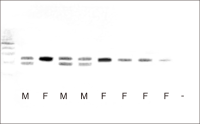
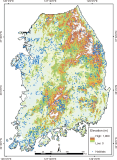
초록
The conservation of the raccoon dog (Nyctereutes procyonoides) in South Korea requires the protection and preservation of natural habitats while additionally ensuring coexistence with human activities. Applying habitat map modeling techniques provides information regarding the distributional patterns of raccoon dogs and assists in the development of future conservation strategies. The purpose of this study is to generate potential habitat distribution maps for the raccoon dog in South Korea using geospatial technology-based models. These models include the frequency ratio (FR) as a bivariate statistical approach, the group method of data handling (GMDH) as a machine learning algorithm, and convolutional neural network (CNN) and long short-term memory (LSTM) as deep learning algorithms. Moreover, the imperialist competitive algorithm (ICA) is used to fine-tune the hyperparameters of the machine learning and deep learning models. Moreover, there are 14 habitat characteristics used for developing the models: elevation, slope, valley depth, topographic wetness index, terrain roughness index, slope height, surface area, slope length and steepness factor (LS factor), normalized difference vegetation index, normalized difference water index, distance to drainage, distance to roads, drainage density, and morphometric features. The accuracy of prediction is evaluated using the area under the receiver operating characteristic curve. The results indicate comparable performances of all models. However, the CNN demonstrates superior capacity for prediction, achieving accuracies of 76.3% and 75.7% for the training and validation processes, respectively. The maps of potential habitat distribution are generated for five different levels of potentiality: very low, low, moderate, high, and very high.
Abstract
The conservation of the raccoon dog (Nyctereutes procyonoides) in South Korea requires the protection and preservation of natural habitats while additionally ensuring coexistence with human activities. Applying habitat map modeling techniques provides information regarding the distributional patterns of raccoon dogs and assists in the development of future conservation strategies. The purpose of this study is to generate potential habitat distribution maps for the raccoon dog in South Korea using geospatial technology-based models. These models include the frequency ratio (FR) as a bivariate statistical approach, the group method of data handling (GMDH) as a machine learning algorithm, and convolutional neural network (CNN) and long short-term memory (LSTM) as deep learning algorithms. Moreover, the imperialist competitive algorithm (ICA) is used to fine-tune the hyperparameters of the machine learning and deep learning models. Moreover, there are 14 habitat characteristics used for developing the models: elevation, slope, valley depth, topographic wetness index, terrain roughness index, slope height, surface area, slope length and steepness factor (LS factor), normalized difference vegetation index, normalized difference water index, distance to drainage, distance to roads, drainage density, and morphometric features. The accuracy of prediction is evaluated using the area under the receiver operating characteristic curve. The results indicate comparable performances of all models. However, the CNN demonstrates superior capacity for prediction, achieving accuracies of 76.3% and 75.7% for the training and validation processes, respectively. The maps of potential habitat distribution are generated for five different levels of potentiality: very low, low, moderate, high, and very high.






_학술지_디자인_시안_koar_top_300x55.png)
